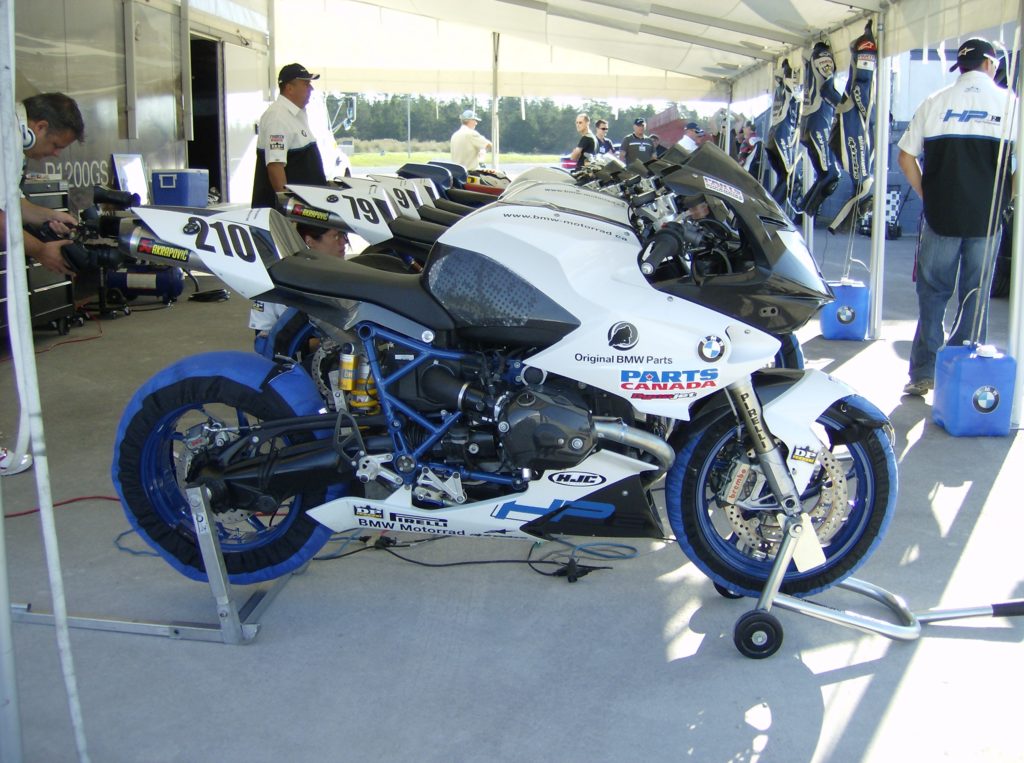Do I Really Need Tire Warmers?

If not for racing, what about just for Track Days?
Road Racers in the early 90’s had a totally different strategy of competition than they do today. The bikes lined up on the grid and began racing after the green flag dropped. The first corner was a balancing act as everyone fought their desire to charge to the front with their own personal tolerance of risk and confidence. The first lap was slow, with each following lap being faster and faster, until the tires warmed and the rider’s confidence rose, then they went racing. Today, the first flying lap is often the fastest with far fewer casualties, and the remaining lap times are far more consistent, with racers going for the win from the out lap. This global difference in race strategy is due to the advent of a small blanket about 200mm wide and 2 metres long… the tire warmer. This device has not only changed the face of competition and race strategy, but it has allowed the tire manufacturers to design a totally different product, so much so that the use of tire warmers today is pretty much mandatory.
To prove this point, when you buy a Pirelli Super Corsa Pro race tire at the racetrack, you are quoted a desired minimum Hot tire pressure with a written recommended time on the warmers of 45 mins @ 70-80 deg C. (158-176 deg F). In speaking with Kevin Graham, Pirelli’s Canadian Race Tire Supplier, he also suggested putting the warmers back onto the tires immediately following a session at a lower ‘maintenance’ setting of about 135 deg F., then, before you head back out for another practice session set the warmer back to your 155-160 standard warm up setting.
Way back in 2000, the Michelin tire engineers told me that DOT Race Tires are now designed around the use of Tire Warmers. I was given a cold tire pressure, then instructed to heat the tires with tire warmers for 45 minutes to an hour before going out on track. Right after the track session, the engineer took the tire core temperatures with a pyrometer and suggestions to change the pressure were given dependent on the tire temperature observed. Wayne Kennedy, the Canadian Representative for Michelin Road Race Tires gave me this chart in print stating… “For best results – front tires should be on warmers at 70-75 deg C for a maximum of one hour and rear tires should be on warmers at 80 to 84 deg C for a maximum of one hour. Tires should never be left on warmers more than 90 minutes.” The chart goes on to state “Operating temps in excess of 130C/266F front or 150C/302F rear after running indicates you have a set up problem or possibly the incorrect tire for the track.
Sandy Noce from Pro 6 cycle, the Canadian Dunlop Race Tire Supplier doesn’t go so far as to say tire warmers are mandatory, but highly recommends them. He likens starting a track session on a cold tire to a cold engine. You wouldn’t start putting a cold motor under load for all the same reasons, nothing is up to operating or design temperature and things will get damaged until you do. Tires can cold tear and have their life significantly reduced by being abused before they warm up. Dunlop recommends setting tire pressures cold as being a more accurate method of ensuring repeatable performance. Sandy stresses that your hot tire pressure depends on too many variables to control, such as warmer’s setting itself, quality of it’s insulation, ambient air temp, proximity of the fender to the warmer’s thermostat, is it windy, and how long has the warmer been on for. All of these factors determine how hot the tire will get and these all determine what the final hot pressure will become. Sandy said the end all method to confirm tire selection and pressure is to check the core temperature off the track. Dunlop, Michelin, Pirelli and Bridgestone usually post pressures on a dry erase board where you pick up your tires to suggest a pressure for you to start at depending on the track, track condition, temperatures and their experience based on History or recent pyrometer readings. All the manufacturers pointed out that the race tires operate in a narrow temperature window for best performance. Street tires provide less ultimate traction when hot, but more grip over a much wider temperature range (read cold), which is why they don’t require warmers.
John Bickle, manufacturer of some of the best and most popular tire warmers in the paddock stresses that it takes a certain amount of time to heat up the surface rubber and the tires carcass, but it takes significantly longer to heat soak the rim as well, and until that happens your tire pressure hasn’t yet stabilized. John also supplies blankets to encompass the tire warmer and rim for days when the ambient temperature or the presence of wind makes heating the tire difficult. The upscale Bickle warmers, responding to the requirements of the various tire manufacturers, have variable set points allowing you to pick your temperature based on your own plan.
Since tire warmers have become commonplace, more and more of their benefits have been realized. The primary reason for their invention was likely to eliminate the dangers of the rider having to slide around in peril for three laps waiting for the tires to ’come in’. Every racer will tell you they have crashed on cold tires at least once in their career before they forked out for a set of warmers. Secondly, riders soon realized they did a lot less damage to their tires when they hit the track hot and weren’t stressing them cold. The purchase price of the warmers can be totally offset with the reduced number of tires required over the course of a year. Tire warmers can be put back on and left at a lower temperature (if available on the warmer) to reduce the number of heat cycles the tire sees over a day, a proven killer to the quality of the tire, and Bickle even suggests putting the warmer on unplugged at the end of the day to let the tire cool slowly as rapid cooling has been known to shock the rubber compound, altering it for the worse. Finally, you can practice as hard as you can immediately preventing you from wasting ½ a session waiting for your tires to warm up. Although they can be pricey, warmers will pay for themselves quickly in saved tires, saved bodywork, and most importantly your safety!
